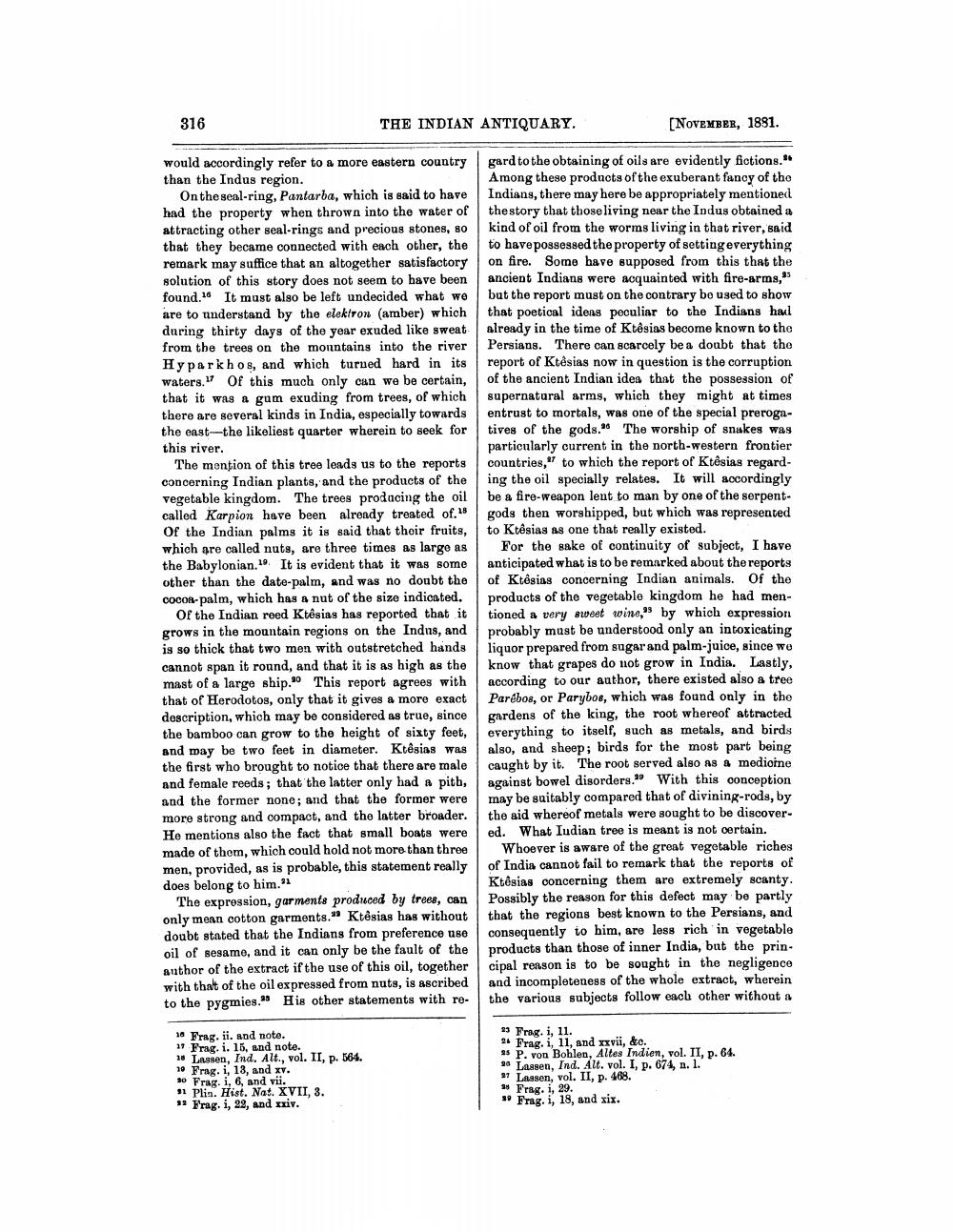________________
316
THE INDIAN ANTIQUARY.
[NOVEMBER, 1881.
would accordingly refer to a more eastern country gard to the obtaining of oils are evidently fictions." than the Indus region.
Among these products of the exuberant fancy of the On the seal-ring, Pantarba, which is said to have Indians, there may here be appropriately mentioned had the property when thrown into the water of the story that those living near the Indus obtained a attracting other seal-rings and precious stones, 80 kind of oil from the worms living in that river, said that they became connected with each other, the to have possessed the property of setting everything remark may suffice that an altogether satisfactory on fire. Some have supposed from this that the solution of this story does not seem to have been ancient Indians were acquainted with fire-arms, found.16 It must also be left undecided what we but the report must on the contrary bo used to show are to understand by the elektron (amber) which that poetical idens peculiar to the Indians haul during thirty days of the year exuded like sweat already in the time of Ktêsias become known to the from the trees on the mountains into the river Persians. There can scarcely be a doubt that the Hyparkhos, and which turned hard in its report of Ktesias now in question is the corruption waters. Of this much only can we be certain, of the ancient Indian idea that the possession of that it was a gum exuding from trees, of which supernatural arms, which they might at times there are several kinds in India, especially towards entrust to mortals, was one of the special prerogathe east-the likeliest quarter wherein to seek for tives of the gods." The worship of snakes was this river.
particularly current in the north-western frontier The mention of this tree leads us to the reports countries," to which the report of Ktêsias regardconcerning Indian plants, and the products of the ing the oil specially relates. It will accordingly vegetable kingdom. The trees producing the oil | be a firo-weapon lent to man by one of the serpent. called Karpion have been already treated of. gods then worshipped, but which was represented Of the Indian palms it is said that their fruits, to Ktôsias as one that really existed. which are called nuts, are three times as large as For the sake of continuity of subject, I have the Babylonian. It is evident that it was some anticipated what is to be remarked about the reports other than the date-palm, and was no doubt the of Ktôsias concerning Indian animals. Of the COCOA-palm, which has a nut of the size indicated products of the vegetable kingdom he had men
Of the Indian reed Ktosias has reported that it tioned a very sweet wine," by which expression grows in the mountain regions on the Indns, and probably must be understood only an intoxicating is so thick that two mon with outstretched hands liquor prepared from sugar and palm-juice, since we cannot span it round, and that it is as high as the know that grapes do not grow in India. Lastly, mast of a large ship.90 This report agrees with according to our author, there existed also a tree that of Herodotos, only that it gives a more exact Parébos, or Parybos, which was found only in the description, which may be considered as true, since gardens of the king, the root whereof attracted the bamboo can grow to the height of sixty feet, everything to itself, such as metals, and birds and may be two feet in diameter. Ktêsias was also, and sheep; birds for the most part being the first who brought to notice that there are male | caught by it. The root served also as a medioine and female reeds; that the latter only had a pith, against bowel disorders. With this conception and the former none; and that the former were may be suitably compared that of divining-rods, by more strong and compact, and the latter broader. the aid whereof metals were sought to be discoverHo mentions also the fact that small boats were ed. What Iudian tree is meant is not certain. made of them, which could hold not more than three Whoever is aware of the great vegetable riches men, provided, as is probable, this statement really of India cannot fail to remark that the reports of does belong to him."
Ktêsias concerning them are extremely scanty. The exprossion, garments produced by trees, can Possibly the reason for this defect may be partly only mean cotton garments." Ktesias has without that the regions best known to the Persians, and doubt stated that the Indians from preference use consequently io him, are less rich in vegetable oil of sesame, and it can only be the fault of the products than those of inner India, but the prin. author of the extract if the use of this oil, together cipal reason is to be sought in the negligence with that of the oil expressed from nuts, is ascribed and incompleteness of the whole extract, wherein to the pygmies." His other statements with re- the various subjects follow each other without a
18 Frag. ii. and note.
Frag. i. 15, and note. * Lassen, Ind. Alt., vol. II, p. 564. 1. Frag. i, 13, and xv. 30 Frag. i, 6, and vii. 11 Plin. Hist. Nat. XVII, 3. 33 Krag. i, 22, and xxiv.
33 Fragi, 11. 2. Frag. 1, 11, and xxvii, &o. as P. von Bohlen, Altes Indien, vol. II, p. 64. * Lassen, Ind. Alt. vol. I, p. 674, n. 1. * Lassen, vol. II, p. 468. 1 Frag. i, 29. » Frag. i, 18, and xix.




